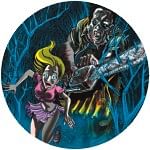
By Gokhra and Mood Dude
 Gokhra (G): Cars. We just love them. So much so that we have dreams within our dreams of driving cool hot cars. Or at least one of us does. I just jump into his dream, hide the keys and annoy the heck out of him.
Gokhra (G): Cars. We just love them. So much so that we have dreams within our dreams of driving cool hot cars. Or at least one of us does. I just jump into his dream, hide the keys and annoy the heck out of him.
Mood Dude (DM): Right. Once in a while car comes out and we go all drooling over the paintwork like crazy pigeons in a car park. It's so amazing that we spend 82 words just to build up a suitable intro.
(G): It's a big mean car but not built in the typical American style of going fast ONLY in a straight line. It could go round corners too except we were never allowed to test one by General Motors. Rather crude design though considering they shoved in a big fat engine from a big fat truck. Now it's an 8.4-liter V-10 with a whopping 600 horsepower.
(DM): Now we always go on about horsepower. But what is it actually? Let's clear it up.
Horsepower is when one horse goes up to another and says “Charlie Dude, let's go to the top of the hill, eat some sugar laden cake laced with sugar and race down the hill.”
 Charlie Dude of course agrees and then on their way down they meet a few other horses who all decide to run out of the way. In a few seconds that number of horses all running down the hill can rise to 600. And suddenly one horse trips and causes a chain reaction that makes all the other horses trip. Together they form a large horse-filled ball five stories high rolling down a hill and wiping out small objects called countries.
Charlie Dude of course agrees and then on their way down they meet a few other horses who all decide to run out of the way. In a few seconds that number of horses all running down the hill can rise to 600. And suddenly one horse trips and causes a chain reaction that makes all the other horses trip. Together they form a large horse-filled ball five stories high rolling down a hill and wiping out small objects called countries.
That, dear readers, is 600 horsepower.
(G):It's also got 560 lb.-ft. of torque. That is enough to pull the earth out of its gravitational field. It still has the exhausts coming out from the sides. Cool as they look they do generate a lot of heat, heat that boils the door sill inside so if you touch it, you say 'ouch' quite loudly.
(DM): Just look at the size of them. A small dog could get lost inside.
(G): With great power comes great responsibility, responsibility for stopping. The Viper comes with 14-inch brake rotors gripped by huge Brembo calipers. An anti-lock braking system (ABS) prevents lockup during hard braking bringing the slightly heavy beast to a stop that's so good it become a benchmark braking performance. 60-to-0 mph in less than 100 feet.
(DM): Top speed comes in at 305.8 kph/190 mph with 100kmph coming in within 4.0 seconds.
(G): It's definitely not an everyday car. Apparently there is plenty of noise inside at all times. But most of it is glorious snarling V10 noise. That's enough to drown out annoying friends who come along for the ride.
(DM): Its handling while great does have a bite.
(G): Hmm, wonder why its called a Viper.
(DM): Its character is like a race car with oversteer providing great tail out slides across tracks. Of course someday, we will be driving these things and not bothering to write because we will be having too much fun. Till then there are the dreams.

By Shahmuddin Ahmed Siddiky
 The Gore Score
The Gore Score
Gore is 'in' big time.
The last decade of the past millennium had Bruce Willis skid under massive oil tankers, fight weapon-laden one-eyed villains with bare fists and come back with victory. Spin the clock a little backward- and there are random changes in Blockbuster styles and themes. The 60s saw the rise of balloon skirts and big budget musicals with towering orchestras (note: West Side Story, Oliver! and the likes). The 70s tamed teen comedies and of course, the 80s was the era of cheesy, rated adult films. Yes, we have come far.
Talk of the 2000s, we are stepping into a lot of muck and gore. Literally. Not that it is bad. With a score of movies like Saw, Hostel and Kill Bill, the studios are flinging themselves on gore. Images of scantily-laden maidens no longer draw in cash for Hollywood; rather, it is ruthless bloodshed that is filling the piggy bank for the producers these days.
 The old saying went: “sex sells”. But with us stepping into the 21st century, it would be more appropriate to say, “Gore sells”. The new generation directors and movie makers are increasingly focusing on the harrowing aspects of horror and thriller. The threshold has scaled up. The competition is intense. The aim is to make the scenes more and more realistic- almost to the point that the audience feels physically present while a screaming victim is being dissected alive or an eyeball is being gauged off.
The old saying went: “sex sells”. But with us stepping into the 21st century, it would be more appropriate to say, “Gore sells”. The new generation directors and movie makers are increasingly focusing on the harrowing aspects of horror and thriller. The threshold has scaled up. The competition is intense. The aim is to make the scenes more and more realistic- almost to the point that the audience feels physically present while a screaming victim is being dissected alive or an eyeball is being gauged off.
Quentin Tarantino is one of the pioneers in this kind of movies. He has piped out the well-crafted Kill Bill series, with hours of blood sprays, torture and has had his characters chop each other off.
Technically speaking, however, gore has never been alien to the silver screen. It is just that censorship was more stringent as to what could be dished out to the people. The original Texas Chainsaw Massacre tested the waters. Then there was Friday the Thirteenth and Nightmare on Elm Street with Jason and Freddy Krueger (respectively) being elevated to the level of all-time-favourite and the scariest movie monsters. They still, no doubt, hold on to their positions. A similar line was taken by Mike Myers in Halloween. Nonetheless, all these were mere previews of what the successive decades were about to offer…
 The movie Hostel and its sequel added yet another facet to this genre. Apart from the blood baths and the constant amputation of human organs, it concentrated on its torture scenes. The result was elaborate shots of people being tortured in every possible way the imagination stretches. A girl was hung upside down and slashed alive, with the blood being used for a shower; a torturer-cum-wannabe-surgeon slowly- almost languidly- cut up a live human being with scalpels and other surgical accessories (which surprisingly included a drill machine!). And of course, their screams alone were enough to give the thin-skinned average Joe nightmare for a couple of weeks. One of the behind-the-scenes clips showed that the Director had channeled a lot of energy to the screams- badgering the actors to scream to perfection (or so to say).
The movie Hostel and its sequel added yet another facet to this genre. Apart from the blood baths and the constant amputation of human organs, it concentrated on its torture scenes. The result was elaborate shots of people being tortured in every possible way the imagination stretches. A girl was hung upside down and slashed alive, with the blood being used for a shower; a torturer-cum-wannabe-surgeon slowly- almost languidly- cut up a live human being with scalpels and other surgical accessories (which surprisingly included a drill machine!). And of course, their screams alone were enough to give the thin-skinned average Joe nightmare for a couple of weeks. One of the behind-the-scenes clips showed that the Director had channeled a lot of energy to the screams- badgering the actors to scream to perfection (or so to say).
With these movies flaunting their Blockbuster status, the audience was hungering for yet more. Saw (and later, its sequels) offered just that. Put in all that gore, all that torture, all that agony of being a witness… and there is more: a psychological drama. Throw in a bit of mind game and a cat-and-mouse wild chase, the picture is almost complete. Instead of the movie-goers just sitting through reels of bashing and slashing, they were getting more for a single ticket. This time around, they were sitting, rigid, on the edge of their seats trying to assemble the pieces of the puzzle together.
Again, psychological thrillers and gore- the combination- was not altogether novel. Anthony Hopkins breathed life into Hannibal “The Cannibal” Lecter in the Silence of the Lambs and Fargo had actors stuffed up meat grinders. But like most old-school films, the thrill was all intact but the gore was nothing out of the ordinary.
Gore has settled its score with the major Hollywood studios (at least we hope that it has). Despite the intense criticism that “gore is no art” and “violence corrupts young minds”, this string of movies continue to entertain… and terrorise. Terror sells. Blood sells. Oh well, you might as well keep your eyes clamped shut on those scenes. Then again, you better keep those eyes open. Because those scenes are going to run long… and long… and longer.
RS Music

By Tareq

More and more kids these days seem to take into the whole bling-bling style of things. Kids in chains, baggy pants, headphones plugged in ears blaring the newest 50 beat, etc. And yet, if you actually ask them about Hip Hop in general they'd probably only stare in answer. Let me enlighten you.
Hip hop music started in the mid 1970s, the historical 'old school' era lasting from 1970 to 1985 after which came the 'golden era' which lasted until 1993 in which developed the East and West Coast 'gangsta rap' and G-Funk genres of hip hop. Afterwards came the era of hardcore hip hop and the bling-bling era that defines the current modern styles.
 The music genre started in New York's Bronx and it wasn't even a style of music then. It mostly consisted of DJs isolating percussion breaks from funk songs, while MC would come and introduce the DJ and in general keep the crowd piqued up. Eventually MC-ing became more stylized, taking precedence over the DJs and the rappers were born.
The music genre started in New York's Bronx and it wasn't even a style of music then. It mostly consisted of DJs isolating percussion breaks from funk songs, while MC would come and introduce the DJ and in general keep the crowd piqued up. Eventually MC-ing became more stylized, taking precedence over the DJs and the rappers were born.
Throughout the 1970s the rappers and DJs were limited to block parties. Early songs and hip hop beats were mostly taken from or were modified Funk and Disco songs. These types of songs were called 'breakbeat' DJ-ing.
As hip hop became more and more popular the first commercially produced hip hop album was released by The Sugarhill Gang coined Rappers' Delight. Incidentally this was the first time that the term 'rapper' was coined.
During the 80s hip hop began to diversify and become rhythmically more complex. The beats took on more changes and began to be more and more creative than the former isolated percussion breaks as DJ began scratching and delving in electronic production and recording. The rappers started to experiment with more lyrically versatile songs, using assonance, alliteration and quick rhyming. They also collaborated with rock bands creating sub-genres like conscious hip-hop, jazz-rap, etc.
Notable among successful commercial rap crews of the 80s are the NWA, Public Enemy, Wu Tang Clan etc. The rapper Ice Cube also generated a lot of attention and controversy with the album AmeriKKKa's Most Wanted.
In the 90s, the rappers 2Pac and The Notorious B.I.G. broke into the mainstream by releasing both commercially and critically chart topping albums. They also caused a lot of rife by being the front runners of the West Coast East Coast rivalry, which is claimed to have resulted in their deaths.
In Bangladesh the hip hop genre is still in its infant stages with only a handful of artist practicing it. Notable among them are the rap crew Stoic Bliss with their successful debut album Light Years Ahead.
Game zone

By Tareq Adnan
 The magical frenzy instigated by Potter 07 is still going strong, so in lieu with that general feeling this week, it's GrimGrimoire, another game steeped in magical fantasy and which incidentally borrows heavily from the Potter world.
The magical frenzy instigated by Potter 07 is still going strong, so in lieu with that general feeling this week, it's GrimGrimoire, another game steeped in magical fantasy and which incidentally borrows heavily from the Potter world.
The game is an RTS based around Lillet Blan; a teenager just offered a chance to enroll in the prestigious mage school Silver Star Tower Academy. She has enormous potential in her and the school is headed by this legendary hero who imprisoned an evil Archmage within the tower of the school. Quite familiar if you paid attention to what you just read.
The story has a very nice time twist. After four days of normal school attendance the fifth day results in everyone in the school either dead or dying and for some reason Lillet is transported back fives in time. She now has to relive the days to the catastrophe and try and stop it. You have to relive those five days quite a few times to complete the story.
The graphics of the games are 2D but quite delightfully artistic and detailed and the environs mesh together to give a cohesive feel to the whole atmosphere of the magic school (something which the HP games could learn from). The animations are fluid and the characters models seem impressively alive (even though some of them can be very weird).
The sound score is very nice; the voice acting especially is top notch, giving the characters that human feel. The other sound effects, like the standard roars and occasional thwacks and explosions also have a satisfactory effect on the game. The in game music actually is pretty good and enhances the feeling of magic but they could have done better for the battle sequences.
This is a 2d RTS game and lots of you are wondering what to expect. The learning of the controls are pretty easy thanks to the decent tutorials within the game. The game actually puts you in a certain area on the map and from there you have to explore and complete objectives. The downside is that the halls and passage ways all look alike and boredom and monotony tend to settle in pretty quick. The resource gathering part of the game is thankfully limited only to one thing, manna, which is a crystal that you have to mine out. The magic learned at the school is based on four different arts Glamour, Sorcery, Alchemy and finally Necromancy. Each art allowing the summoning of different types of monster to do your bidding. Learning these arts depend of the finding and using of different 'grimoires'. In terms of combat it isn't that hard to master and the AI of opponents range from boringly easy to very difficult, although not frustrating. Sometimes surviving a certain time period is all that is needed.
In short the game is worth playing, even if it borrows from Potter. In reality EA should learn from Vanillaware and try to improve its own franchise. This game is quite unique and innovative and those who enjoy epic fantasies of magic and adventure will definitely enjoy this one.

 On the occasion of 'friendship day', Gaanchil Productions is releasing the first album of Nobonita Chowdhury. The solo album, titled <<“Ami Jontro, Tumi Jontri”,>> comprises ten mesmerizing Lalon songs. The music of the album has been arranged by the leading contemporary musician Ayub Bacchu.
On the occasion of 'friendship day', Gaanchil Productions is releasing the first album of Nobonita Chowdhury. The solo album, titled <<“Ami Jontro, Tumi Jontri”,>> comprises ten mesmerizing Lalon songs. The music of the album has been arranged by the leading contemporary musician Ayub Bacchu.
“We might wear fancy clothes, eat well, live in big houses but that can not bring in our mental peace. Often we are not content with our lives without even knowing what we want for and that creates the whole feeling of emptiness. Time and again, I have the feeling that just like me, the seemingly successful people around are enduring such discernment of hopelessness and emptiness”, wrote Nobonita in her album cover.
She added, “From that desolation, one day I have realized that whenever I sing, I can sense spirituality, feel divine mysticism as music takes away all my restlessness, all the despair. One can get the sense of eternity through Lalon songs, it bridges between the mundane world and perpetual realm. I hope these ten soul searching Lalon songs would be able to calm the anguish and desolation of the listeners at least for moments”.
“When I heard Nobonita singing for the first time at AB Kitchen, she immediately impressed me with her beautiful but unique voice. Her exceptional melancholic voice attracts anyone naturally and obviously. I appreciate both Nobonita's love for Lalon Songs and her belief in Lalon's philosophy”, Bacchu said about Nobonita and her music.
Though this is the first time Ayub Bacchu is arranging music for Lalon Songs as he did not come across the suitable singer to work with, he always has had passion for Lalon songs. AB said, “Nobonita does not sing to impress others rather she sings from her heart in quest of her soul”.
“One of the most delightful aspects of Nobonita is her very own and unique style of singing Lalon Songs. She doesn't try to imitate any other singer”, Bacchu wrote on the album cover.
The ten songs of< “Ami Jontro, Tumi Jontri” >are Satya bal supathe chal, Samay gele shadhon hobe na, Kon naame dakile tare, Khomo Khomo oporadh, Shadhur jugol charandhuli, kobe hobe shojol borosha, Itorpona kaarjo amar, Vobe manush guru nishtha jaar, Paap punner kotha, Emon manob jonom ar ki hobe.
